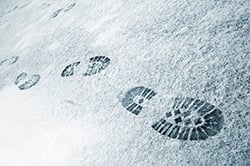 When winter weather strikes it can dramatically change your workplace. Snow, ice, freezing rain, and cold temperatures bring with them a whole new set of safety hazards than the rest of the year. Taking proper precautions can help keep workers safe throughout winter. Consider these 4 hazard areas:
When winter weather strikes it can dramatically change your workplace. Snow, ice, freezing rain, and cold temperatures bring with them a whole new set of safety hazards than the rest of the year. Taking proper precautions can help keep workers safe throughout winter. Consider these 4 hazard areas:
Cold Weather
Just as we remind our children to wear their coats, hats, and gloves when going out in the cold, it is also critical for individuals working in cold temperatures to dress appropriately. Educate employees on the impact cold weather can have on the body including cold stress, frostbite, and hypothermia and what precautions they can take to avoid these injuries. Provide time for workers to get acclimated to working in cold weather. Consider adjusting the length of outdoor shifts. And make sure appropriate personal protective equipment is worn at all times.
Slippery Surfaces
When there is snow and ice, workers face a greater hazard of slips, trips, and falls. Ensure all walking and working surfaces are clear of snow and ice. Keep an eye on the forecast and be ready to spread deicer as quickly as possible to prevent a build-up of ice. When walking on snow or ice is unavoidable, educate workers on the importance of wearing proper footwear and encourage them to take walk slowly and with short steps to help prevent injury. You can also consider posting signs in working areas especially prone to wet or slippery surfaces in winter, installing floor surfaces with grit to help maintain friction, and making sure the area has good lighting.
Snow Removal
Shoveling snow, using snow blowers, and removing snow from roofs bring hazards for your workers. OSHA provides several recommendations on how to reduce these hazards, which we have summarized below:
- Shoveling Snow – Cold weather can be quite tasking on the body, so when individuals are shoveling snow they can be at risk for exhaustion, dehydration, back injuries, and even heart attacks. Encourage workers to take frequent breaks in warm areas and to push the snow rather than lifting it.
- Using Powered Equipment Like Snow Blowers – Ensure equipment is properly grounded to prevent electric shock or electrocutions. Train employees on proper maintenance and cleaning procedures.
- Clearing Snow From Roofs & Working At Heights – When clearing snow from heights extra caution is critical. See OSHA’s Hazard Alert on the topic for tips and suggestions.
Winter Driving
Winter weather can wreak havoc on the roads. You want your employees to arrive safely at work every day, so consider educating all workers on safe winter driving best practices. And for some of your employees, driving in winter weather may be an integral part of their job. To help prevent accidents, train these individuals on safe driving behaviors and how to recognize winter driving hazards. You should also have driver safety policies in place and an effective maintenance program for all vehicles and mechanized equipment. Prepare emergency kits to include in all vehicles. Visit OHSA’s Safe Driving page for more tips and resources.
To keep your workers safe and reduce the likelihood of injury, make sure your workplace safety policies and procedures address these winter weather hazards.



